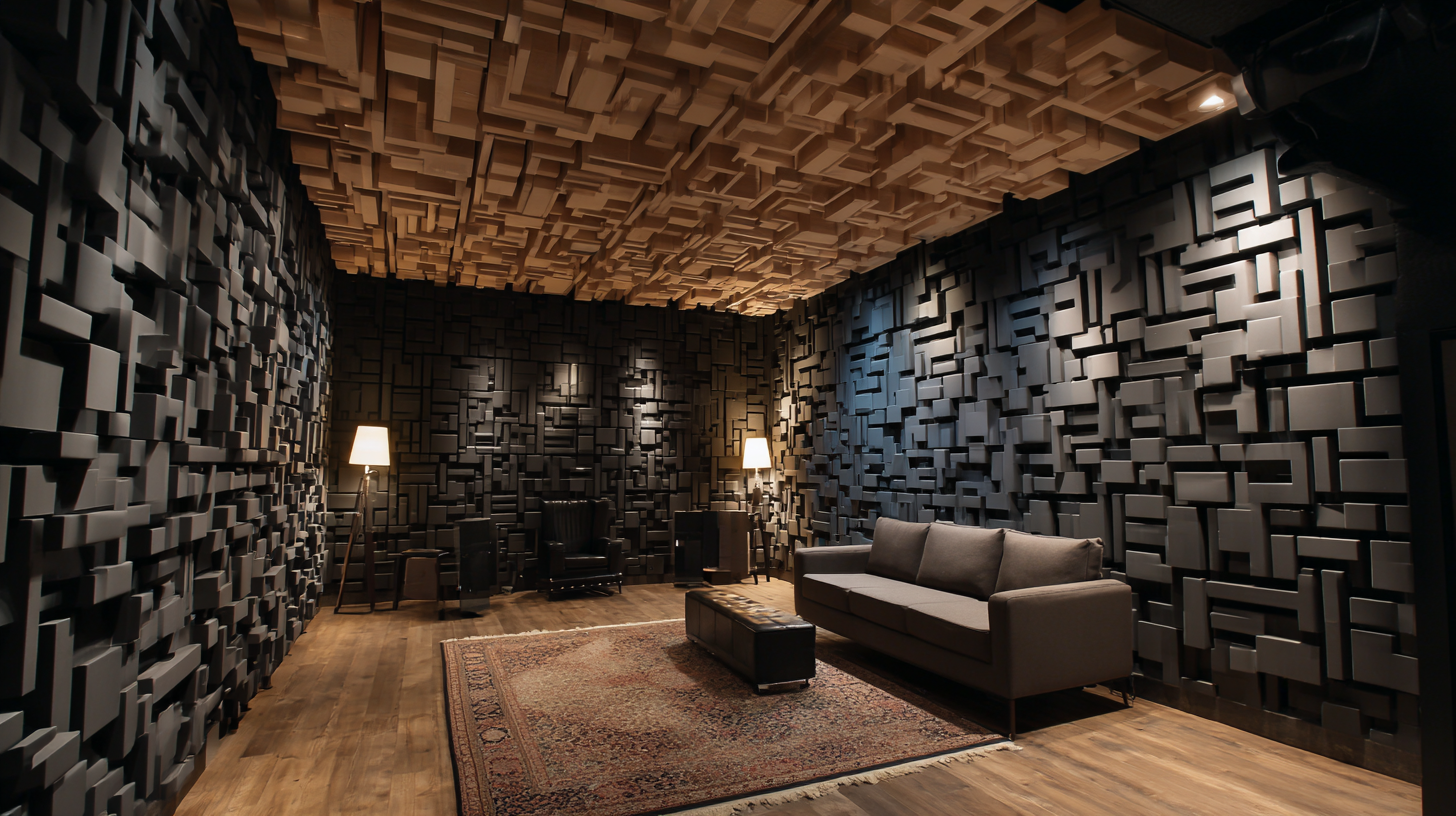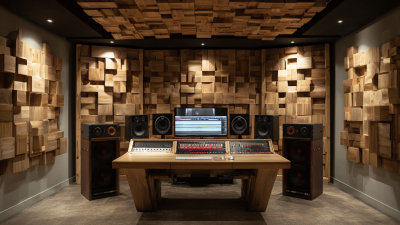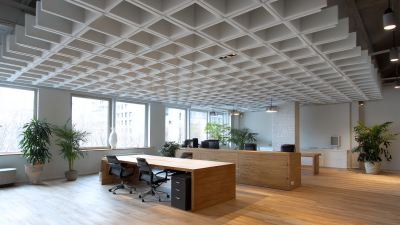Blog
Transform Your Space: The Ultimate Guide to Acoustic Treatment Panels for Superior Sound Quality
In today’s fast-paced world, achieving superior sound quality in both personal and professional spaces has become a priority. Acoustic treatment panels have emerged as essential tools for enhancing auditory experiences, whether in home theaters, recording studios, or offices. According to a recent report by the Acoustical Society of America, properly designed acoustic treatment can reduce sound reflections by up to 90%, significantly improving clarity and reducing distortion. This dramatic enhancement aids in creating an environment conducive to focus and creativity, demonstrating the critical role acoustic treatment panels play in sound design. With the proliferation of digital media consumption and remote working arrangements, investing in effective sound management is more relevant than ever, ensuring that spaces are not only aesthetically pleasing but also acoustically optimized for best performance.

Understanding the Importance of Acoustic Treatment in Your Space
Acoustic treatment is essential for anyone looking to enhance sound quality in their space, be it a home studio, a theater room, or a simple living area. Poor acoustics can lead to muddled sound, making it difficult to enjoy music or engage in conversations. By incorporating acoustic treatment panels, you can significantly reduce unwanted noise and echoes, resulting in a clearer and more enjoyable auditory experience. Understanding how sound behaves in your environment is the first step toward effective treatment.
**Tips:** When selecting acoustic panels, consider the dimensions of your room and the sources of noise. Bass traps can be particularly helpful in corners where low frequencies accumulate. Additionally, strategically placing diffusers on walls can help scatter soundwaves, preventing them from becoming too focused and harsh.
Another important aspect of acoustic treatment is aesthetics. Many acoustic panels come in various designs and colors, allowing them to blend seamlessly with your interior decor. **Tips:** Choose panels that complement your space while maintaining their effectiveness. Incorporating plants or artwork can also enhance both the acoustics and the visual appeal of your environment, creating a harmonious space that is both functional and beautiful.
Acoustic Treatment Panels Effectiveness in Different Frequencies
This chart illustrates the effectiveness of acoustic treatment panels across different frequency ranges, demonstrating how various materials impact sound quality in your space.
Choosing the Right Type of Acoustic Panels for Your Needs
When it comes to enhancing sound quality in your space, choosing the right type of acoustic panels is essential. Acoustic panels come in various materials, shapes, and sizes, each designed to address specific acoustic issues. For instance, foam panels are great for minimizing high-frequency echoes, while fabric-wrapped panels can absorb mid to low frequencies, providing a balanced sound environment. It’s important to assess the unique characteristics of your space, such as dimensions and existing furnishings, to determine the most suitable options.
Tips:
- Consider the room's primary function; for a recording studio, prioritize thicker panels for deeper sound absorption.
- Don't overlook aesthetics! Acoustic panels can be customized in color and design to complement your interior while also improving sound quality.
Beyond just the material and design, placement plays a crucial role in the effectiveness of acoustic treatment. Aim to position panels at reflection points, usually along walls and ceilings, to effectively control sound waves. Additionally, experimenting with panel arrangement can help achieve the best sound reduction for your specific setup. Remember, a well-treated space not only sounds great but also enhances your overall acoustic experience.
How to Properly Install Acoustic Panels for Optimal Performance
 Acoustic panels are crucial for enhancing sound quality in any space, whether it's a home theater, studio, or office. Proper installation is key to optimizing their performance. Begin by assessing the room’s layout and identifying areas with high levels of sound reflection, such as flat walls and ceilings. Positioning panels strategically in these areas will effectively absorb sound waves, reducing echo and creating a more pleasant auditory environment.
Consider the design and material of the panels, as they should complement the aesthetic of your space while providing functional sound absorption.
Acoustic panels are crucial for enhancing sound quality in any space, whether it's a home theater, studio, or office. Proper installation is key to optimizing their performance. Begin by assessing the room’s layout and identifying areas with high levels of sound reflection, such as flat walls and ceilings. Positioning panels strategically in these areas will effectively absorb sound waves, reducing echo and creating a more pleasant auditory environment.
Consider the design and material of the panels, as they should complement the aesthetic of your space while providing functional sound absorption.
When installing acoustic panels, it’s important to use the right tools and techniques. Ensure they are mounted at the correct height and alignment to maximize their effectiveness. For best results, follow the manufacturer's guidelines on spacing, height, and placement, as this can significantly impact sound quality. Incorporating panels made from sustainable materials not only addresses acoustic needs but also aligns with eco-friendly building practices, contributing to overall interior quality and character. As multi-functional spaces gain popularity, balancing sound absorption with design becomes increasingly essential in creating environments that inspire and perform.
Creative Ideas for Incorporating Acoustic Panels into Your Decor
Incorporating acoustic panels into your decor doesn't just enhance sound quality; it also offers a unique opportunity to express your style. Consider using panels with vibrant colors or bold patterns that resonate with the overall aesthetic of your space. For a modern look, geometric-shaped panels can create a stunning visual while effectively reducing noise. Placing these panels strategically along walls or ceilings can transform areas like home theaters, music studios, or even open-concept living spaces into sound-friendly sanctuaries.
Alternatively, think about integrating acoustic panels with your existing furniture. Custom-built bookshelves or wall art frames can cleverly disguise soundproofing solutions while adding character to your room. You can also opt for fabric-wrapped panels that match your upholstery, creating a seamless blend of practicality and decor. By utilizing these creative approaches, you not only improve acoustic performance but also create a harmonious and stylish environment that reflects your personal taste.
Transform Your Space: The Ultimate Guide to Acoustic Treatment Panels for Superior Sound Quality
| Panel Type | Material | Acoustic Rating (NRC) | Color Options | Best Uses |
|---|---|---|---|---|
| Wall Panels | Fiberglass | 0.85 | Black, White, Blue, Green | Recording Studios, Home Theaters |
| Ceiling Tiles | Mineral Fiber | 0.90 | White, Acoustic Patterns | Offices, Classrooms |
| Baffles | Soft Foam | 0.75 | Various Colors | Gymnasiums, Factories |
| Portable Panels | Fabric Wrapped | 0.80 | Custom Prints, Solid Colors | Live Events, Temporary Studios |
| Diffusers | Wood | 0.70 | Natural Wood Stains | Concert Halls, Theaters |
Tips for Maintaining and Upgrading Your Acoustic Treatment Solutions
Maintaining your acoustic treatment panels is essential for preserving sound quality in any space. Over time, dust and dirt can accumulate on the surface of the panels, which can affect their performance. Regularly cleaning your panels with a soft, dry cloth will help keep them in optimal condition. For deeper cleans, consider using a mild soap solution and a damp cloth, ensuring that the panels are thoroughly dried afterward to prevent moisture damage.

Upgrading your acoustic treatment solutions can also significantly enhance your sound experience. Start by evaluating the current setup; if certain areas still suffer from echo or unwanted noise, you might want to explore additional panel types, such as bass traps or diffusers. Investing in higher-quality materials that offer improved absorption properties can lead to noticeable changes. Additionally, positioning your panels strategically in the room can maximize their effectiveness, so consider experimenting with different layouts to find what works best for your unique space.
Related Posts
-

Exploring Noise Insulation Innovations: Insights from the 138th Canton Fair 2025 and Industry Growth Projections
-

The Science Behind Acoustic Treatment Panels and Their Impact on Sound Quality
-

Transform Your Space: The Ultimate Benefits of Noise Reduction Panels for Home and Office
-

Exploring Acoustic Windows Trends at 2025 China Import and Export Fair
-

Understanding the Science Behind Noise Reduction Panels and Their Impact on Acoustic Comfort
-

Exploring the Impact of Sound Absorption Panels on Industry Trends at the 138th Canton Fair 2025
